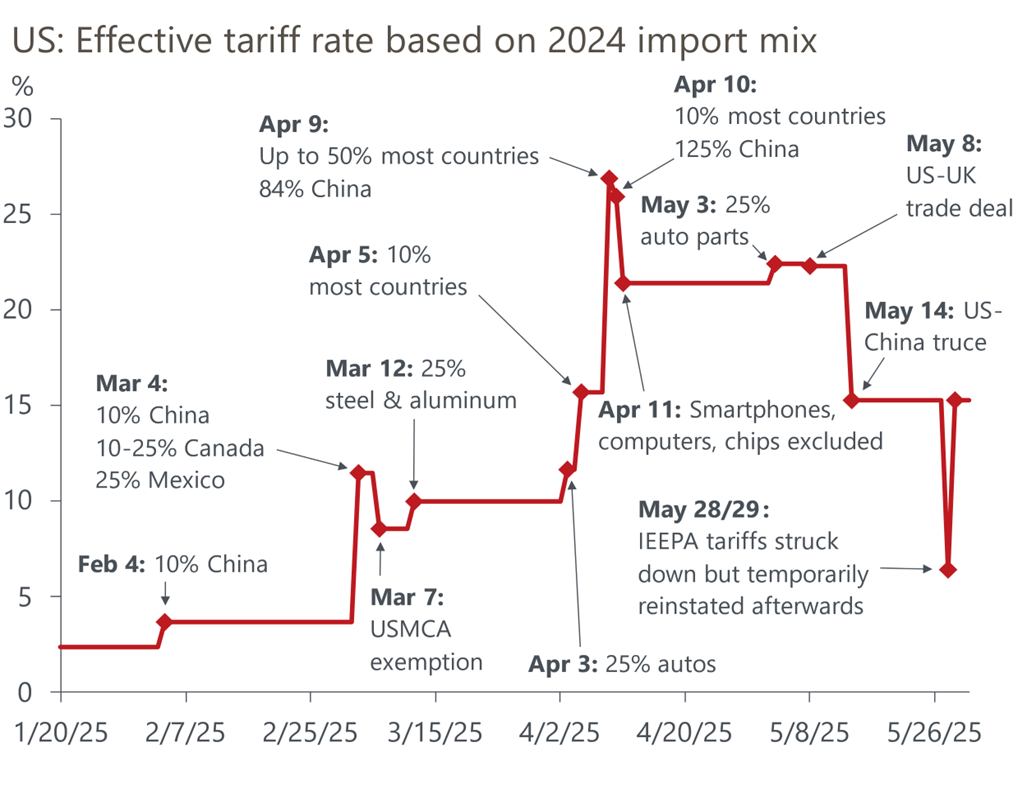
Market Updates

May was marked by significant market movements and a continued complex macroeconomic and geopolitical landscape. Equity markets experienced a notable rally, driven by a temporary pause in US-China tariffs and a US court ruling that initially blocked most of Trump’s global tariffs. This led to substantial gains in US equities, with the S&P 500 futures up 5% and the Nasdaq 100 up 8.7% in GBP terms.
Strong earnings reports from major tech companies, particularly Nvidia, further boosted investor confidence in the tech sector, contributing to the overall market gains. However, the temporary trade truce also impacted other asset classes, with precious metals like gold and silver experiencing relative weakness as investors shifted their focus to equities and other riskier assets.
The FTSE 250 index also performed well, rising by 6.5% over the month, benefiting from strong earnings reports, positive economic data, reduced trade tensions, and positive sector performance in technology and consumer goods. The Bank of England’s decision to cut the Bank Rate by 0.25% to 4.25% also positively impacted market sentiment, further supporting the index’s performance.
In the UK more generally, macroeconomic data has been relatively strong, with GDP growth surprising to the upside and retail sales remaining robust. The Bank of England has continued to cut rates and has upgraded its growth forecasts for the year. The UK government announced trade deals with India and the US, which, while not game-changing for growth, are positive developments in an increasingly fragmented global trade landscape. However, there is scepticism among economists about the true level of underlying economic strength, with concerns about inflation surprising to the upside, increased government borrowing, and the potential for fiscal policy to tighten again in October’s budget.
In global currency markets, the pound strengthened versus most major currencies, driven by positive economic data, while the US dollar index initially rose before selling off again during the month, despite positive market sentiment following the US-China trade truce.
The bond market saw a reversal of last month’s moves as risk appetite returned, with riskier credit outperforming safer government bonds. Inflation surprises to the upside and continued upward pressure placed on yields by investors, who are pricing in a medium-term outlook of higher inflation driven by overly loose fiscal policy, also influenced bond market movements.
US treasuries suffered a credit rating downgrade from Moody’s, and UK gilts fell in value despite the Bank of England’s rate cut. Longer-dated bond yields, particularly the 30-year tenor, moved significantly higher over the month, reflecting market concerns over growth and inflation outlooks. The US 30-year Treasury yield hovered near 5%, similar to the UK and Germany, highlighting the caution required in fixed income allocations.
The US tariff policy continues to be a major driver of global financial market sentiment and returns. The 90-day pause for most tariffs between the US and China brought the overall effective US tariff rate down to 15%, from the previous 21-22% level. However, the outlook remains extremely uncertain, with both sides accusing each other of not adhering to the agreed terms. This uncertainty has led to increased market volatility, with investors closely monitoring any developments in the trade negotiations.

Overall, the financial markets remain highly sensitive to developments in US trade policy, economic data, and geopolitical machinations, and we remain intensely focused on developments here as we expected volatility to remain elevated across asset classes.
As always, portfolio diversification will be crucial in mitigating risks associated with market fluctuations and economic instability. By adopting a strategic approach that emphasises diversification, we can help to guide you through these uncertain times and ensure that investment portfolios are well-positioned for long-term success.
To take a deeper dive into the May update, listen to our Market Update podcast where Portfolio Manager, Harry Scargill and Investment Director, Oliver Stone discuss key market events and trends throughout May 2025, covering everything from equity market rallies to sector highlights as well as an update on global trade policies.
We have over 1250 local advisers & staff specialising in investment advice all the way through to retirement planning. Provide some basic details through our quick and easy to use online tool, and we’ll provide you with the perfect match.
Alternatively, sign up to our newsletter to stay up to date with our latest news and expert insights.
| Match me to an adviser | Our advisers |
The value of investments may fluctuate in price or value and you may get back less than the amount originally invested. Past performance is not a guide to the future. The views expressed in this publication represent those of the author and do not constitute financial advice.